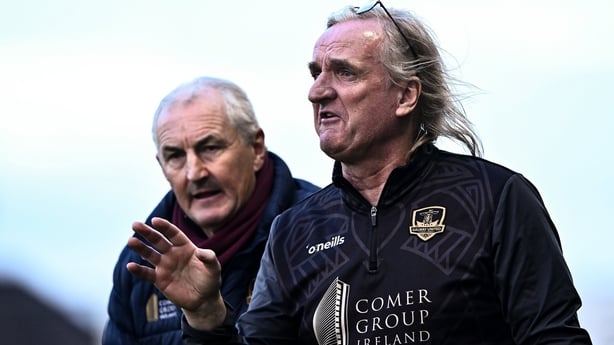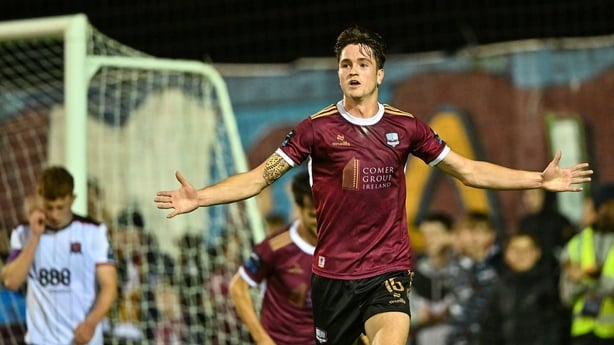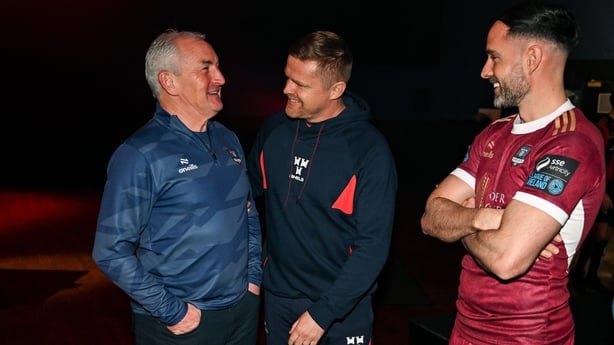Though he played down their faint title hopes during last season's hectic run-in, John Caulfield doesn't take that well to the suggestion that Galway United may have "over-performed" in 2024.
"Where should we have been last year?" he says, after a slightly tense pause.
Eh, well. Em. You know... First year after promotion...
"Yeah but the first year I gave up amateur football to go over Cork City, we took it to the last game of the season to be in with a chance of winning the league (in 2014). And they'd finished third bottom the year before (sixth but we won't quibble).
"Ollie and myself work our a**e off to get players to work hard. We go into compete in every match thinking we can win and give everybody a game. I think last year that's what we showed.
"We didn't score enough goals. Defensively, we were okay. But this is probably a tougher league than last year. For us it is about establishing ourself in the league alongside everyone else."
The Galway United manager was speaking to reporters at the 2025 League of Ireland launch, which was taking place in an impressive drawing room in Dublin's Mansion House. Three years earlier, the same launch was held on the roof garden of Clarehall Shopping Centre in Darndale, a less plush sounding location although one that had its advantages.
For one thing, the builders weren't booked in on the same day in Darndale. During the Caulfield chat last week, a Black & Decker drill started boring holes in the room above, which caused reporters to wince and glance around at the panicked league officials. Caulfield, however, ploughed on and kept going with his answers as if no disturbance was audible.
It was at the 2022 launch where Caulfield's legendary assistant Ollie Horgan spoke of his challenges in the transfer market ahead of what would be his final season as Finn Harps manager.
Back then, Horgan bluntly admitted that Harps couldn't find "value for money" in the Irish market and had to cast the net very wide for players. Horgan didn't inform RTÉ Sport at the time how far he'd travelled in order to source players, reasoning that since he hadn't told his wife he wasn't about to tell the public.

While Galway United are hardly as strapped as Harps were - no one is - in 2022, the refrain has a similar ring this time around.
"It's simple, I think. Everybody can see that boundaries in the league have changed," says Caulfield.
"The four Dublin clubs are exceptionally strong. In the past you might have had two strong Dublin clubs and two that were not so strong but the four are exceptionally so at the moment. Then you've Derry who are strong too.
"We're not going to pull a player from the Leinster side of the country over to Galway. Financially we can't compete.
"I think the challenge for us is we have a lot of money going into accommodation as part of the players' package. A lot of clubs don’t have to do that.
"We've done reasonably okay with a few of the foreign guys, Patrick Hickey and Vincent Borden, so we see that market as giving value for money.
"That’s really why we’ve gone outside the country. It’s very difficult from where we’re based in Galway to attract Irish players.
"We're trying to bring through our own fellas and maybe try to poach some players from the First Division but we didn’t think there was much there this year."
In the off-season, Caulfield tapped into the North American scene, one he knows especially well. New Zealander Moses Dyer was signed from Vancouver FC, while Sligo-born Sean Kerrigan returns from the US collegiate game where he was playing for Michigan State Spartans.
Australian midfielder Daniel Stynes - whose parents are from Dublin and Tipperary but does not seem to be a relation of the famous Jim Stynes, who made the opposite journey - joins from Newcastle Jets in the A-League.
Their two existing graduates of the American college soccer eco-system, Patrick Hickey and Vincent Borden, have thrived at Galway, fitting in particularly well with their preferred style of play. They remain at the club heading into 2025.
"One of things we've found with the fellas in the club already, or on trial, is that they’re suited to our league," says Caulfield. "They’re extremely fit guys, they train really hard, they seldom miss games.
"I don’t think it’s physicality, more endurance, their DNA growing up in the States, they’re athletes.
"I wouldn’t say they’re not into partying as such but from an early age they’re trained as athletes coming through college, their whole demeanor and DNA is trying to be professional. You nearly know what you’re going to get from the States."

With Dubs especially thin on the ground in the squad - veteran goalkeeper Brendan Clarke is the only one on the books - the westerners are heavily made up of players from Limerick, Cork, foreign imports as well as a smattering of locals.
Former international Greg Cunningham returned from Preston last year and captains the team ahead of 2025, with striker Stephen Walsh and defenders Colm Horgan and Regan Donelon comprising the rest of the local contingent.
Galway had provided a rich seam of League of Ireland stars in the 2010s, with Stephen O'Donnell, Patrick Hoban and Daryl Horgan all central figures in Dundalk's era of dominance under Stephen Kenny.
John Russell, now Sligo Rovers manager, won a league title with St Pat's in 2013, while Tuam's Rory Gaffney has been a stalwart for Shamrock Rovers in the early 2020s, winning the PFAI Player of the Year award in 2022.
Galway United, who ceased to exist for a couple of years after their 2011 financial collapse, saw little benefit from this boom.
Hoban, from Loughrea and now 34, finished top goalscorer in the league for the fourth time last season but Caulfield pours cold water on the notion of any return to the west.
"With the Galway lads, their careers were gone too far before we became competitive," says Caulfield
"Galway were struggling since going into receivership in 2011. It took a long time, we weren't back in the Premier Division until last year. There aren’t Galway lads in their mid-20s out there who we wanted to get back in.
"To be fair to those lads, they're at clubs where the wage structure is significantly higher than ours.
"I suppose they don’t really have any affiliation to Galway United. I know they’re from Galway but League of Ireland players have generally been from outside the county."
While Galway, traditionally a heavily GAA-centric county, has had a good decade in terms of producing players and the league overall is in the rudest health it's been in for well over half a century, Caulfield joins the chorus calling for further investment from government.

It's 10 months since the league's academy development director Will Clarke outlined in stark terms the threadbare nature of the domestic academy structure in Ireland and Caulfield says it's imperative they get financial help in order to produce more Mason Melias et al.
"We're crying out, last year was the first full-time league in the division from what I remember.
"You have to have government investment, you have to have academies bringing through more of our own players. We haven’t been doing enough of that and academies need to get better.
"We need government funding, we haven’t got a slice of the pie for 100 years and the more pressure we put on government, the more investment we get in the league.
"Why can't we have a professional league? If you look around the other sports like rugby or whatever, we should be able to support a full-time league and you have to have investment and academies. You have to keep the pressure on."
Listen to the RTÉ Soccer podcast on Apple Podcasts, Spotify or wherever you get your podcasts.


